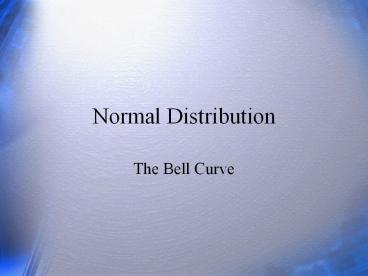Normal%20Distribution - PowerPoint PPT Presentation
Title:
Normal%20Distribution
Description:
Normal Distribution The Bell Curve Questions What are the parameters that drive the normal distribution? What does each control? Draw a picture to illustrate. – PowerPoint PPT presentation
Number of Views:148
Avg rating:3.0/5.0
Title: Normal%20Distribution
1
Normal Distribution
- The Bell Curve
2
Questions
- What are the parameters that drive the normal
distribution? What does each control? Draw a
picture to illustrate. - Identify proportions of the normal, e.g., what
percent falls above the mean? Between 1 and 2
SDs above the mean? - What is the 95 percent confidence interval for
the mean? - How can the confidence interval be computed?
3
Function
- The Normal is a theoretical distribution
specified by its two parameters. - It is unimodal and symmetrical. The mode, median
and mean are all just in the middle.
4
Function (2)
- There are only 2 variables that determine the
curve, the mean and the variance. The rest are
constants. - 2 is 2. Pi is about 3.14, and e is the natural
exponent (a number between 2 and 3). - In z scores (M0, SD1), the equation becomes
(Negative exponent means that big z values give
small function values in the tails.)
5
Areas and Probabilities
- Cumulative probability
6
Areas and Probabilities (2)
- Probability of an Interval
7
Areas and Probabilities (3)
- Howell Table 3.1 shows a table with cumulative
and split proportions
z Mean to z Larger F(a) Smaller
0 0 .5 .5
.5 .1915 .6915 .3085
1 .3413 .8413 .1587
1.96 .4750 .9750 .0250
Graph illustrates z 1. The shaded portion is
about 16 percent of the area under the curve.
8
Areas and Probabilities (3)
- Using the unit normal (z), we can find areas and
probabilities for any normal distribution. - Suppose X120, M100, SD10. Then z(120-100)/10
2. About 98 of cases fall below a score of
120 if the distribution is normal. In the
normal, most (95) are within 2 SD of the mean.
Nearly everybody (99) is within 3 SD of the
mean.
9
Review
- What are the parameters that drive the normal
distribution? What does each control? Draw a
picture to illustrate. - Identify proportions of the normal, e.g., what
percent falls below a z of .4? What part falls
below a z of 1?
10
Importance of the Normal
- Errors of measures, perceptions, predictions
(residuals, etc.) X Te (true score theory) - Distributions of real scores (e.g., height) if
normal, can figure much - Math implications (e.g., inferences re variance)
- Will have big role in statistics, described after
the sampling distribution is introduced
11
Computer Exercise
- Get data from class (e.g., height in inches)
- Compute mean, SD, StErr of Mean in Excel
- Compute same in SAS PROC UNIVARIATE
- Show plots (stem-leaf Boxplot)
- Show test of normality































